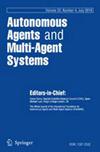具有单边偏好的最优匹配:固定和基于成本的配额
摘要
我们考虑了一个研究得很好的多对一二部匹配问题,即分配申请人\({\varvec{\mathcal {A}}}\)到职位\({\varvec{\mathcal {P}}}\),其中申请人按偏好顺序排列职位。这种设置模拟了许多重要的现实世界分配问题,比如给学生分配课程,给申请人分配工作等等。在这种情况下,要求分配满足“匹配至少80”形式的保证是很自然的% of applicants to one of their top three choices” or “it is unacceptable to leave more than 10% of applicants unassigned”. The well-studied notions of rank-maximality and fairness fail to capture such requirements due to their property of optimizing extreme ends of the signature of a matching. We, therefore, propose a novel optimality criterion, which we call the “weak dominance ” of ranks.We investigate the computational complexity of the new notion of optimality in the setting where posts have associated fixed quotas. We prove that under the fixed quota setting, the problem turns out to be NP-hard under natural restrictions. We provide randomized algorithms in the fixed quota setting when the number of ranks is constant. We also study the problem under a cost-based quota setting and show that a matching that weakly dominates the input signature and has minimum total cost can be computed efficiently. Apart from circumventing the hardness, the cost-based quota setting is motivated by real-world applications like course allocation or school choice where the capacities or quotas need not be rigid. We also show that when the objective is to minimize the maximum cost, the problem under the cost-based quota setting turns out to be NP-hard. To complement the hardness, we provide a randomized algorithm when the number of ranks is constant. We also provide an approximation algorithm which is an asymptotic faster alternative to the randomized algorithm.

We consider the well-studied many-to-one bipartite matching problem of assigning applicants \({\varvec{\mathcal {A}}}\) to posts \({\varvec{\mathcal {P}}}\) where applicants rank posts in the order of preference. This setting models many important real-world allocation problems like assigning students to courses, applicants to jobs, amongst many others. In such scenarios, it is natural to ask for an allocation that satisfies guarantees of the form “match at least 80% of applicants to one of their top three choices” or “it is unacceptable to leave more than 10% of applicants unassigned”. The well-studied notions of rank-maximality and fairness fail to capture such requirements due to their property of optimizing extreme ends of the signature of a matching. We, therefore, propose a novel optimality criterion, which we call the “weak dominance ” of ranks.
We investigate the computational complexity of the new notion of optimality in the setting where posts have associated fixed quotas. We prove that under the fixed quota setting, the problem turns out to be NP-hard under natural restrictions. We provide randomized algorithms in the fixed quota setting when the number of ranks is constant. We also study the problem under a cost-based quota setting and show that a matching that weakly dominates the input signature and has minimum total cost can be computed efficiently. Apart from circumventing the hardness, the cost-based quota setting is motivated by real-world applications like course allocation or school choice where the capacities or quotas need not be rigid. We also show that when the objective is to minimize the maximum cost, the problem under the cost-based quota setting turns out to be NP-hard. To complement the hardness, we provide a randomized algorithm when the number of ranks is constant. We also provide an approximation algorithm which is an asymptotic faster alternative to the randomized algorithm.

 求助内容:
求助内容: 应助结果提醒方式:
应助结果提醒方式:


